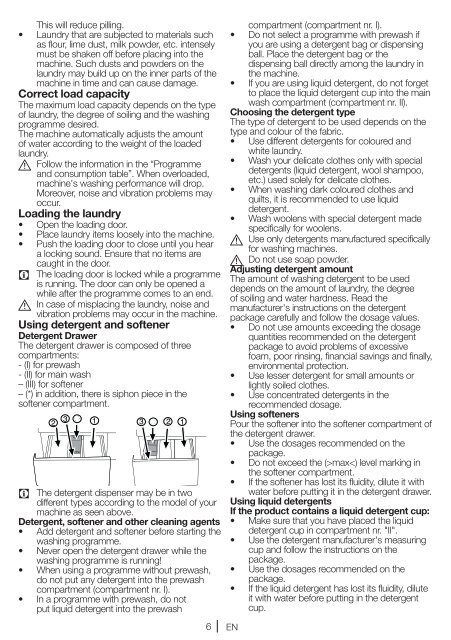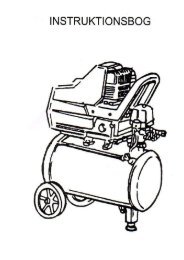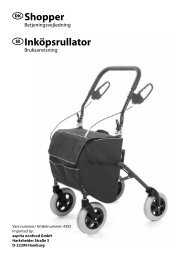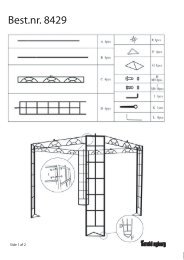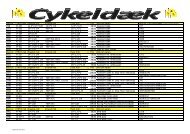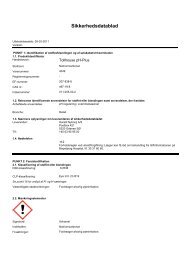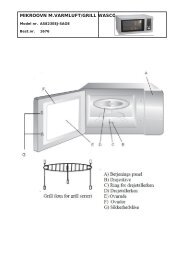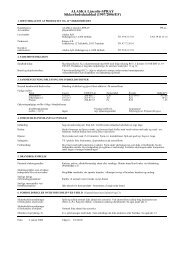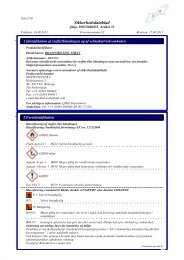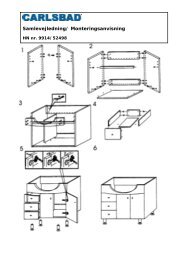Vaskemaskine LS1603E - Harald Nyborg
Vaskemaskine LS1603E - Harald Nyborg
Vaskemaskine LS1603E - Harald Nyborg
You also want an ePaper? Increase the reach of your titles
YUMPU automatically turns print PDFs into web optimized ePapers that Google loves.
This will reduce pilling.<br />
• Laundry that are subjected to materials such<br />
as flour, lime dust, milk powder, etc. intensely<br />
must be shaken off before placing into the<br />
machine. Such dusts and powders on the<br />
laundry may build up on the inner parts of the<br />
machine in time and can cause damage.<br />
Correct load capacity<br />
The maximum load capacity depends on the type<br />
of laundry, the degree of soiling and the washing<br />
programme desired.<br />
The machine automatically adjusts the amount<br />
of water according to the weight of the loaded<br />
laundry.<br />
A<br />
Follow the information in the “Programme<br />
and consumption table”. When overloaded,<br />
machine's washing performance will drop.<br />
Moreover, noise and vibration problems may<br />
occur.<br />
Loading the laundry<br />
• Open the loading door.<br />
• Place laundry items loosely into the machine.<br />
• Push the loading door to close until you hear<br />
a locking sound. Ensure that no items are<br />
C<br />
A<br />
caught in the door.<br />
The loading door is locked while a programme<br />
is running. The door can only be opened a<br />
while after the programme comes to an end.<br />
In case of misplacing the laundry, noise and<br />
vibration problems may occur in the machine.<br />
Using detergent and softener<br />
Detergent Drawer<br />
The detergent drawer is composed of three<br />
compartments:<br />
- (I) for prewash<br />
- (II) for main wash<br />
– (III) for softener<br />
– (*) in addition, there is siphon piece in the<br />
softener compartment.<br />
C<br />
2 1 3 3 2 1<br />
The detergent dispenser may be in two<br />
different types according to the model of your<br />
machine as seen above.<br />
Detergent, softener and other cleaning agents<br />
• Add detergent and softener before starting the<br />
washing programme.<br />
• Never open the detergent drawer while the<br />
washing programme is running!<br />
• When using a programme without prewash,<br />
do not put any detergent into the prewash<br />
compartment (compartment nr. I).<br />
• In a programme with prewash, do not<br />
put liquid detergent into the prewash<br />
6 EN<br />
compartment (compartment nr. I).<br />
• Do not select a programme with prewash if<br />
you are using a detergent bag or dispensing<br />
ball. Place the detergent bag or the<br />
dispensing ball directly among the laundry in<br />
the machine.<br />
• If you are using liquid detergent, do not forget<br />
to place the liquid detergent cup into the main<br />
wash compartment (compartment nr. II).<br />
Choosing the detergent type<br />
The type of detergent to be used depends on the<br />
type and colour of the fabric.<br />
• Use different detergents for coloured and<br />
white laundry.<br />
• Wash your delicate clothes only with special<br />
detergents (liquid detergent, wool shampoo,<br />
etc.) used solely for delicate clothes.<br />
• When washing dark coloured clothes and<br />
quilts, it is recommended to use liquid<br />
detergent.<br />
• Wash woolens with special detergent made<br />
specifically for woolens.<br />
A Use only detergents manufactured specifically<br />
for washing machines.<br />
A<br />
Do not use soap powder.<br />
Adjusting detergent amount<br />
The amount of washing detergent to be used<br />
depends on the amount of laundry, the degree<br />
of soiling and water hardness. Read the<br />
manufacturer's instructions on the detergent<br />
package carefully and follow the dosage values.<br />
• Do not use amounts exceeding the dosage<br />
quantities recommended on the detergent<br />
package to avoid problems of excessive<br />
foam, poor rinsing, financial savings and finally,<br />
environmental protection.<br />
• Use lesser detergent for small amounts or<br />
lightly soiled clothes.<br />
• Use concentrated detergents in the<br />
recommended dosage.<br />
Using softeners<br />
Pour the softener into the softener compartment of<br />
the detergent drawer.<br />
• Use the dosages recommended on the<br />
package.<br />
• Do not exceed the (>max


